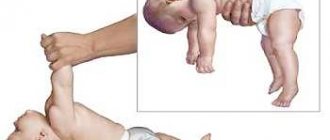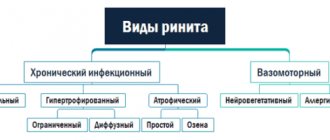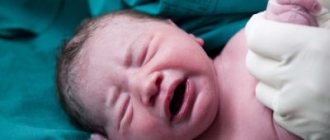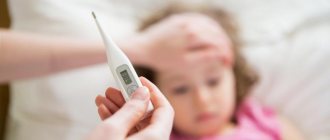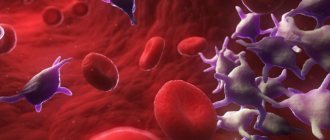Determination of muscle hypotonicity in infants
Most doctors perceive muscle weakness as a physiological developmental feature that can be corrected. This condition is detected by routine testing, subjecting muscle tissue to tension.
If a reverse reaction occurs when bending an arm or leg, the baby immediately straightens his limb, there is no problem. Hypotonia in an infant is diagnosed when a response does not occur, or it appears late. The pathology is associated with the fact that the muscles cannot contract on their own.
Symptoms of muscle hypotonia in infants
Nervous tic of the eye in a child under one year old - causes, symptoms
Having noticed weak muscle tone in a newborn, the neurologist continues to examine the baby to determine the extent of the problem. Several manipulations are used to diagnose the disease.
Step reflex
When a baby is placed on a table, with normal development, feeling support under him, he will take a few steps or try to sit down. With hypotonia in the legs of an infant, such reflexivity is absent. The baby cannot straighten his legs, sit down, or even take a step with them.
These actions are practiced on children under 2 months of age. Then the innate reflex fades, and the diagnosis is carried out in a different way.
Lying down
The doctor places the baby on his back on the changing table. She takes the baby by the arms and begins to lift him up, trying to bring the little one into a sitting position. With normal development, the newborn will strain his muscles, pull himself up on his arms, trying to help the adult.
Diagnostic method
For your information. With weak muscle tone, a completely different picture is observed in a child. The little one sticks his stomach out and hangs on his arms. At the same time, the back is rounded, and the head can barely hold on.
What is muscle hypertonicity
A newly born little person always experiences muscle strain. This deviation is explained by the fact that during prenatal development the child is in a curled position, where the limbs are pressed to the body.
As soon as he begins to live, all his systems and organs must adapt to other conditions and recover within six months.
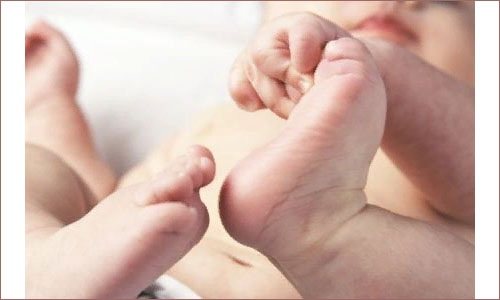
Muscular hypertonicity in infants begins to subside as soon as they control their movements. At this time, their flexion reflex is more developed. It is necessary to provoke skin receptors more often (children respond well to them), in response to which extensor receptors will also develop.
In the first month, the child’s tension manifests itself especially clearly:
- closed fists;
- bent legs, which, with strong resistance, move apart;
- putting the head on the back.
If there are no developmental abnormalities, then by the age of 3 months such symptoms disappear on their own.
To improve the development of different muscle groups, you need to carry out the following activities with your kids:
- do not swaddle the child, which will allow him to move his arms and legs independently;
- gymnastics classes;
- light full body massage;
- provoke a positive reaction from the baby to affectionate communication;
- perform warm water procedures every day.
But if there is tension in the child’s muscular system, which does not go away until six months, then it is necessary to take action and contact the attending doctor for advice.
Self-diagnosis of the disease
Neurology in newborns - symptoms of abnormalities and disorders
Dr. Komarovsky advises mothers to exercise more often with their baby. This will allow timely detection of muscle hypotension in a child. Even in a calm position, you can detect a symptom of pathology in a newborn.
Signs of hypotension in an infant
| Body area | Symptoms of the disease |
| Hands | It is considered normal for a sleeping baby to have his palms clenched into fists and his arms slightly bent at the elbows. Completely relaxed limbs are already evidence of hypotonicity in the arms of an infant. Children with reduced muscle activity have difficulty grasping and holding objects. They practically do not touch the breast or bottle with their hands during feeding. |
| Legs | In a healthy newborn, the limbs are slightly bent; with hypotonia, they are straightened. If a lying baby's legs are spread 180°, then in normal muscle condition this will cause discomfort. A sick child will not react to this manipulation in any way. |
| Neck and vertebrae | Muscular hypotonia in a baby does not allow him to hold his head normally. Weak tissues in the spine area do not allow the baby to roll over on his own. |

The baby can't hold his head up well
This table allows you to answer the question of whether it is possible to determine hypotension in a one-week-old newborn. To be sure of the problem, the mother should observe the baby for several days and then share her doubts with the pediatrician.
If a child actually exhibits the symptoms described, it is difficult to teach him to crawl and squat. Subsequently, he will not be able to independently move from a lying position to a sitting position.
Among other signs of hypotension in infants, doctors identify the following:
- the baby is overly calm;
- never gets excited;
- slow during waking hours;
- sleeps a lot;
- does not take the breast well or refuses to suckle at all.
Any of the symptoms is already a reason to contact your local pediatrician in order to promptly diagnose hypotension in an infant.
Hypertonicity: a course for relaxation
Did a neurologist discover hypertonicity in your baby? Do not panic! Let's figure out what this problem is and how to deal with it. A newborn is characterized by an embryonic position: the arms are bent, the fists are at chest level, the legs are pulled up to the stomach and slightly spread apart, the head is thrown back a little. Crescent stacks. This grouping is a sign of tension in the flexor muscles. At 3-3.5 months the baby begins to move more actively, and by six months the muscles relax. However, for some children this does not go away. Doctors call this disorder hypertonicity. This is not a disease, but a signal: not everything is in order with the child’s nervous system. Sometimes, to identify the problem, the baby undergoes neurosonography - ultrasound of the brain. In special cases, after six months the doctor will prescribe a tomography. But these methods are rarely used. An experienced doctor will detect hypertonicity in the baby already at the first examination (the baby should be seen at one month). The specialist will immediately prescribe the therapy. After all, even a slight delay in a child’s motor development is very difficult to catch up with! You can relieve muscle tension without medication. Therapeutic gymnastics, massage, swimming, relaxing baths and, of course, mother’s tenderness and love will help. Without extreme There are procedures that are strictly contraindicated for hypertonicity! The baby is not allowed to dive (you can and should swim!). Mothers whose children suffered hypoxia at birth should monitor this especially closely. For a baby, diving is a serious nervous strain. Dynamic gymnastics activates all systems of the body, including the nervous system. It will not help cope with hypertension, but will harm the psyche of an overly excitable child. SOS signals Tense muscles are not the only symptom of hypertension in a baby. Some other signs also cannot be ignored. The baby cries for no reason, while his lips and nails turn blue, his chin trembles. The baby doesn't sleep well and flinches at noise. The child's head is thrown back, his hands are clenched into fists, his thumbs are inside. Place your baby's feet on the surface and tilt him forward slightly. Does he rest on his entire foot? Good girl! With hypertonicity, he would rise on his toes. Start treatment immediately! Follow the doctor’s recommendations, but take into account the characteristics of the baby’s body. Then the procedures will be beneficial. Massage Massage course – 10-15 sessions. It must be repeated at intervals of a month until complete recovery. If the course is carried out correctly, the baby’s motor activity increases.
HANDS Lightly massage your hands: from palms to shoulders. Go around the elbow pits and joints. Stroke your hands and each finger as if you were putting on gloves for your little one. LEGS Now move on to the legs. Path of movement – feet, legs, hips. Taboo areas: knee joints and pits, inner thigh, groin area. Take your foot in your palm and bend and straighten the leg at the hip and knee joints. FEET Draw a figure eight on the foot: start from the base of the toes, make a cross in the center of the foot, and at the end stroke the heel (press lightly). Massage your toes, stroke your foot from heel to toes. Gymnastics The purpose of each exercise is to stimulate motor activity and certain reflexes of the baby. Place the baby on his side and stroke his back from the buttocks to the neck along the spine. Don't press on the skin! The little one will arch. Press on the foot under the toes, then on its inner surface. The child will bend her fingers in response. After this, run your hand along the outer edge of the foot - it will straighten it. Repeat.
Causes of the disease
How to understand that a baby has a headache - signs and symptoms
The described developmental pathology can be found not so often. If it appears, it is necessary to clarify the reason that provoked the problem. The predominant factors are usually disturbances in the functions of the central nervous system and improper blood circulation in the body. This situation can be triggered by the following:
- complications during childbirth: fetal hypoxia, asphyxia, trauma;
- rapid delivery;
- bad habits that the woman did not give up during an interesting situation;
- severe pregnancy and related diseases;
- the birth of a baby with low birth weight or prematurely;

Born prematurely
- improperly organized infant nutrition from the first weeks of life;
- infectious and viral diseases that lead to depletion of the baby’s body;
- Excessive intake of vitamin D by the baby;
- developmental pathologies and various defects.
The cause of weakened muscle tone can also be genetics, when the baby inherits a serious illness. Regardless of where hypotension lies, it can have serious consequences. The toddler is lagging behind in physical development; it is difficult for him to learn to sit and walk. In a child who spends most of his time without movement, weak muscles begin to atrophy and bones slow down in growth.
As a result, the growing baby develops skeletal deformation, which leads to scoliosis, changes in gait and other serious consequences. In an effort to keep himself in an upright position, the child strains all the internal organs, this provokes the development of all kinds of pathologies.
At what age can hypertension be detected in an infant?
Hypertonicity can be diagnosed not only in the first month after birth. It is extremely difficult to detect it in a newborn child and before he reaches three months. Only a pediatrician can do this.
If the baby's muscle tone is really high and does not correspond to his age norm, then he begins to have problems with the sucking reflex and latching onto the mother's breast. This happens because tense muscles are very difficult to control, especially for a small child. In addition, hypertonicity also affects the muscle layer of internal organs, for this reason children with such a deviation regurgitate the milk they drink. For this reason, stiffness of the child’s movements and adduction of the limbs cannot be considered the only symptomatology of hypertonicity in the baby.

How to increase muscle tone in a newborn
Timely detection of muscle hypotonicity in a child will help slow down the problem in the early stages. Before prescribing therapy, the baby is examined to make sure how developed the other systems are. If drug treatment is required, it will be selected on an individual basis.
Manual therapy – physical exercises and special massages – plays an important role in eliminating muscle weakness. Mother and baby visit a specialist, where she herself learns similar manipulations in order to perform them at home.
Advice. If you have the opportunity to visit the pool, you should go swimming with your little one. Such exercises perfectly eliminate the described syndrome and do not reduce muscle tone.
Light gymnastic exercises
Special gymnastics have long been developed to eliminate muscle hypotonia in infants. If a mother works with her baby every day, she will very quickly achieve a positive result.
Exercises recommended for hypotension
| Name | Description |
| Boxing | Having folded the baby's hands into fists and holding them, the mother alternately bends and straightens his arms, placing the upper limbs in front of the child. For variety, you can perform actions with both hands at the same time |
| Bike | You need to twist the baby’s legs so that you get an imitation of riding this vehicle. |
| Crisscross | The toddler's arms are first spread to the sides, then crossed on the chest |
| Pull-up | Holding the baby’s wrists, they try to slowly move him to a sitting position, then lay him down |
| Leg spread | The lower limbs are first crossed, then spread apart. Start with a small amplitude, gradually increasing it |
The described exercises must be performed comprehensively, smoothly moving from one action to another. The mother determines the sequence of manipulations herself, performing each movement several times.
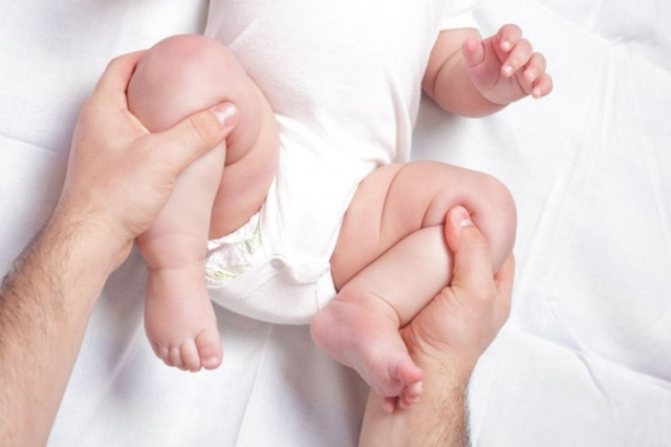
Physiotherapy
Weakened muscles may not respond to exercise, causing the baby to become less fussy. Therefore, during the procedure, no effort should be made so as not to injure the baby.
Massage
To achieve a quick effect, gymnastic exercises must be supplemented with massages. Such manipulations have a beneficial effect on the nervous system and stimulate the functioning of all organs.
In infants, massage for hypotension should become a daily procedure during the first year of life. In addition to home manipulations, it is planned to visit a specialist at least once a quarter with a course of 10 procedures.
You should not limit yourself to massage only problem areas - you need to use all the muscles of the body. Therefore, during the procedure the baby is placed either on his back or on his stomach.
Each time the manipulation begins with the fingers, and at the final stage the back is worked on. During the session, the specialist presses on bioactive points, thereby stimulating nerve impulses. A mother who does not have such experience should limit herself to other manipulations: stroking, tapping, pinching. Any movements must be performed moving from the edges of the area to the center.
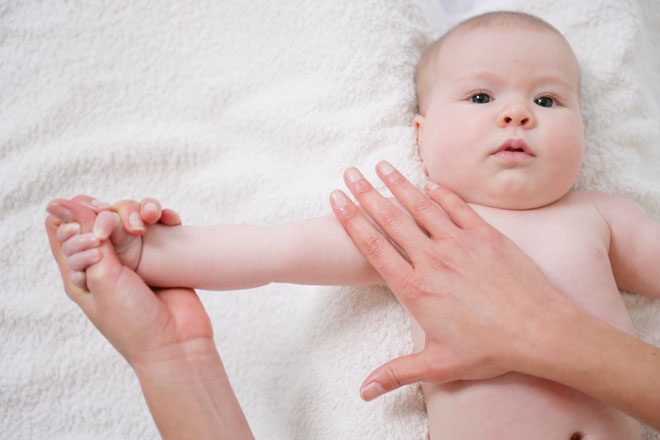
Firming massage
It is recommended to begin the cycle of therapeutic exercises with light massages and end it with them. The best time for manipulation is before feeding the baby, so as not to create additional stress on a full stomach. If a child is sick or in a bad mood, it is better to postpone physical activities for a while.
Other components of therapy
Depending on the degree of damage to muscle fibers, the doctor may prescribe additional procedures that stimulate increased tone. These include:
- visiting a physical therapy room;
- acupuncture;
- herbal baths;
- compresses for sore joints and rubbing.
If you do not limit yourself to single procedures, but carry out a full range of therapy, then after 3 months the little one will begin to actively move his arms and legs, raise his head, try to roll over and even sit down.
Normal tone of children up to one year monthly
To understand how much the baby is lagging behind in development, you need to familiarize yourself with the standards established by WHO for the average infant.
Norms of infant physical development
| Age, month | Peculiarities |
| 0-1 | The newborn exhibits reflexes: grasping, sucking and even stepping. The baby should already turn his head to the smell of breast milk. |
| 1-2 | The baby begins to hold his head up, turn it toward the sound, and follow the toy with his eyes. During this period, children are already trying to suck their fingers and perk up when they see their parents or hear their voices. |
| 2-3 | The child holds his head well in an elevated position. When he lies on his tummy, he confidently leans on his arms. In a vertical position, it rests its legs on the surface and actively pushes off from it. Facial expressions appear on the face. |
| 3-4 | Grasping the mother’s fingers, the baby tries to sit up, moving from a lying position. While lying on his stomach, the child rests firmly on his straightened arms. Examines his fingers, tries to hold a rattle, takes his mother's breast while feeding. The facial muscles have developed well, reflecting the little one’s mood. |
| 4-5 | The baby becomes mobile, actively turns his head in all directions, interested in what is happening around him. When the baby is supported by the arms, he rests steadily on his legs and tries to move them. The hand muscles are well developed: the child takes objects, holds them in his palm and pushes them away. |
| 5-6 | A normally developed baby can sit up independently. He rolls over from his back to his tummy and even tries to crawl. If the baby is helped, he is able to hold a spoon and eat from it. |
| 6-7 | He is already actively crawling, starting to walk, but for now with the help of support. Turns his head towards the objects that are named to him. |
| 7-8 | Stands up independently in the crib and is able to move along supports. He is actively interested in toys and can disassemble and haphazardly assemble pyramids. |
| 8-9 | The baby confidently holds the cup and drinks from it independently. He plays pats by himself and with his mother. Tries to imitate the actions of his parents |
| 9-10 | The baby confidently holds the cup and drinks from it independently. He plays pats by himself and with his mother. Tries to imitate the actions of his parents |
| 10-11 | Most children at this age walk independently, squat and return to a standing position. They know how to find named objects in the house and pick them up. They undress and dress the dolls, as well as themselves. |
| Year | The child not only walks, but already runs. Sits at the table without outside support and eats by himself. Helps mom clean the room, putting away her toys. |
Important! The standards given in the table are conditional. Therefore, if the baby does not fit into the standards, this is not yet a reason to suspect that the child has hypotension. Premature babies are slightly behind in development from their peers.
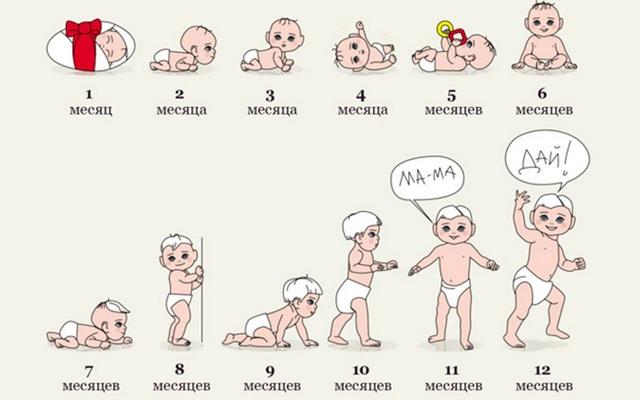
Stages of normal development
If the toddler has difficulty crawling by the due date, this is most likely due to excess body weight. When a baby is unable to hold his head up, does not show a muscular response to external factors, and does not try to roll over, these are clear signs of low tone, and it needs to be addressed urgently.
Increased muscle tone
Answered by Komarovsky E. O.
Let's start with the fact that in children under the age of one year, muscle tone is physiologically (i.e. in the most natural way) higher than in older children. In general, it is sometimes quite difficult for a doctor to determine whether this increase in muscle tone is physiological, i.e. a variant of the age norm, or pathological, i.e. a symptom of some disease. In addition, each individual child has a specific muscle tone , and the variability of the norm is extremely high. I emphasize the norms! Those. according to the books, according to science, it seems to be a serious illness, but the most detailed examination reveals nothing and the child subsequently grows up completely normal. Why do doctors fuss and worry so much when they see a non-standard (or not quite standard) increase in muscle tone ? First of all, because increased muscle tone is a symptom of many very (!) serious diseases. For example: cerebral palsy, congenital anomalies of brain development, severe and prolonged asphyxia during childbirth (severe lack of oxygen), some inborn errors of metabolism accompanied by brain damage, and this list is far from complete. What is important. Having identified increased muscle tone in a child , the doctor understands perfectly well: this symptom should under no circumstances be ignored. However, any dangerous brain disease is distinguished by the fact that increased muscle tone is a typical symptom, but far from the only one. It is always possible to detect disturbances in general development, changes in reflexes, and much more. Serious changes are also revealed when additional research methods are carried out - ultrasound of the brain (neurosonoscopy), computed tomography. If ultrasound is normal, if general psychophysical development is normal, then increased muscle tone is considered as a variant of the norm. Results: identifying an increase in muscle tone requires very specific actions: a) comparison of this symptom with the general development of the child; b) conducting an examination. Further actions: a specific pathology is detected - we treat it. Everything is fine - we leave the child and his parents alone, although we observe them more often than other children - you never know. Summary: “What is the danger of increased muscle tone in children under one year of age?” All this is very similar to a briefcase standing alone in a subway car. It could be a bomb, or maybe some jaded engineer forgot. Having discovered a briefcase, you should call specialists - let them sort it out: this could be very, very serious, or it could be complete nonsense; - an absolute analogy with increased muscle tone ! All answers
